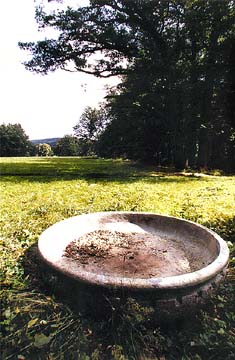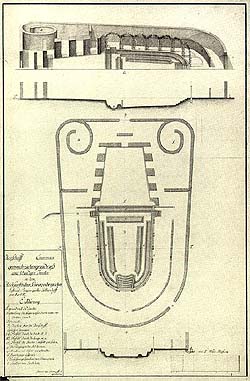Červený Dvůr Castle - Park
Location:
The park is a part of the castle area in Červený Dvůr.
Description of the Place:
The castle park in Červený Dvůr takes over 105 hectares of the
landscaped park situated in both the close environs of the castle
and inside of the castle courtyard and also extensive free areas
spread out to the south-east of the main castle building.
The boarder of the park is formed by the road coming from Český Krumlov to Chvalšiny on the south-west, by a stream on the south-east, by nursery area on the north-east and a local road on the north-west.
An average height above sea level is 550 metres. The whole castle area including the park is situated within the region of Preserved Area of Blanský les.
 Architectural and
Historical Development:
Architectural and
Historical Development:
The garden of the castle in Červený Dvůr is mentioned for the first
time in 1598 - at that time it was a reserve established by Peter
Wok von Rosenberg to bread beavers, pheasants, partridges and
quails.
In 1672 there is a gamekeeper's lodge and a summer-house mentioned in the garden.
In the park a gardener's house was built during the rule of duke Adam Franz zu Schwarzenberg(1680 - 1732). Documents about the construction of the water-supply in 1736 prove the existence of the fountains.
The development of the castle park is also proven in detail by archival records and historical designs filed in the State Regional Archives in Třeboň, Český Krumlov office.
The oldest design in dated 1766. It shows a regular French garden of trapezoid plan bounded with a wall. The paths diverge in a star-shape from the central pool and from the architectural point of view divide the garden space into closed bosquets (bosquet means coppice in the French language).
All the paths except of the central one were lined from both sides
with a cut tree avenue and were led in straight lines. The inside
areas of the bosquets are planted with trees, the north-east part
of the garden there are mostly in the bosquets free grassy and
field areas.
In front of the garden facade the rectangular surface of parterre with a pool in the centre is situated. The main axis of composition starts from the centre of the garden side of the castle facade towards the south-east, crosses the above mentioned pool on the parterre and goes through the big water tank with a little island. A fountain was in its centre (see the analogy of the island with the fountain on the pond in the Český Krumlov castle park - Castle Gardens in Český Krumlov). Other water element on the main axis of the park is a pool with the fountain in the centre of the paths' star. The axis is ended with the oval pool with two fountains. All of the fountains with their high springs of water visually lengthen the whole deepness of the castle park. The round pools with the fountains are repeated in all of four park corners.

|

|
The original entrance to the park from Český Krumlov followed up the line of the crosswise axis of composition. The main gate to the park was on its south side. Other entrance to the park was through the castle courtyard (the so-called courtyard of honour, respectively).
The arrangement of the parterre is in details in the water-colour painting entitled "Červený Dvůr and its surroundings" by the painter Ferdinand Runk, dated 1780. The rectangular surface of the parterre is regularly designed with the elements of the early Baroque style. The centre of the parterre with the circle fountain is designed more pretentiously. In the circular design around the pool the flower beds are spread. In the middle of them there is a wide path leading to the castle. The margins of the parterre are arranged with the flower beds with the inside rectangular dissection.
The archival records mention that in 1764 - 1769 the park was enclosed by a stone wall. The fountains were launched in 1761.
 In 1769 - 1784 the
beavers, Chinese pheasants, Bengal red deer and Angora rabbits were
breaded in the park. To the older park elements (open theatre,
summer riding school, so-called Scheckenberg - a little hill in the
shape of a snail's shell) Holland and Chinese garden houses, a
little island with bridges and a cave made of shining stones were
added in 1787 - 1789. Canadian and Italian poplars, very modern at
that time, were planted in the park.
In 1769 - 1784 the
beavers, Chinese pheasants, Bengal red deer and Angora rabbits were
breaded in the park. To the older park elements (open theatre,
summer riding school, so-called Scheckenberg - a little hill in the
shape of a snail's shell) Holland and Chinese garden houses, a
little island with bridges and a cave made of shining stones were
added in 1787 - 1789. Canadian and Italian poplars, very modern at
that time, were planted in the park.
The design from 1819 shows the Baroque-Classicist park with a partially simplified net of paths but the main system in the shape of the star is still retained. Inside of the bosquets there are irregularly directed paths that are connected by a number of romantic elements that enrich the park.
The biggest changes in the park were made under the rule of Johann Adolf II. zu Schwarzenberg (1833 - 1888). The main impulse to renovate so-called French gardens into the typical landscaped park (so-called English park) was the duke's journey to England.
We have got the information of the overall picture of the park from the design dated 1910. The original trapezoid area of the park was extended on the south and east. The park reached the area of 105 hectares and it remained until today. The regular net of paths was broken but the newly made irregular ways in many cases lead according to the original Baroque design. For example one of the walking route leads to the border of the original Baroque garden. The main axis of composition of the park goes through its centre (it is identical to the original axis of the Baroque garden!) and is enlivened with circular pools with fountains and a pond that was made by reconstruction of the square Baroque pool. The main driveway is really representative. It gives many views of the castle and of the opposite open grassy part of the park. This part of the park is masterly moulded by groups of trees and solitaries. The park was created extravagantly. The individual sceneries formed by romantic buildings are ingeniously connected by a number of views ending in the surrounding countryside to which the park gets on and makes a rounded off picture with the Blanský les hills.
It is written in the archival records that in 1839 the enclosing walls of the park were destroyed. In 1840 a new reserve was founded in the park where the visitors during the season were accommodated, and also so-called Swiss stables to bread the cows by origin from Switzerland. The stables themselves were separated by a glass wall from three halls to allow the visitors to drink fresh milk, watch the work and life in the exemplary kept stables. Near to "Švýcárna" (the nick-name for the stables) a tennis court was built. On a wish of the princess a new rose garden and a rose summer-house were built. In 1846 the obelisk was moved on a so-called cross field. In the fifties of the 19th century the Baroque summer-houses and artificial caves were demolished. In 1856 the Pillar of the Holy Virgin in the Neo-Gothic style was built. This was the end of the artistic development of the castle park.
The list of the most significant woods:
Pseudotsuga menziesii var. glauca
Pinus strobus
Acer rubrum
Gleditsia triacanthos

|

|
Present Use:
Today the park is a part of mental hospital and is not open to the
public.
(jo)




